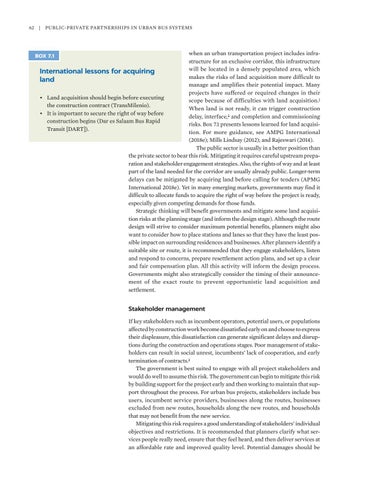62 | Public-Private Partnerships in Urban Bus Systems
when an urban transportation project includes infrastructure for an exclusive corridor, this infrastructure will be located in a densely populated area, which International lessons for acquiring makes the risks of land acquisition more difficult to land manage and amplifies their potential impact. Many projects have suffered or required changes in their • Land acquisition should begin before executing scope because of difficulties with land acquisition.1 the construction contract (TransMilenio). When land is not ready, it can trigger construction • It is important to secure the right of way before delay, interface,2 and completion and commissioning construction begins (Dar es Salaam Bus Rapid risks. Box 7.1 presents lessons learned for land acquisiTransit [DART]). tion. For more guidance, see AMPG International (2018e); Mills Lindsay (2012); and Rajeswari (2014). The public sector is usually in a better position than the private sector to bear this risk. Mitigating it requires careful upstream preparation and stakeholder engagement strategies. Also, the rights of way and at least part of the land needed for the corridor are usually already public. Longer-term delays can be mitigated by acquiring land before calling for tenders (APMG International 2018e). Yet in many emerging markets, governments may find it difficult to allocate funds to acquire the right of way before the project is ready, especially given competing demands for those funds. Strategic thinking will benefit governments and mitigate some land acquisition risks at the planning stage (and inform the design stage). Although the route design will strive to consider maximum potential benefits, planners might also want to consider how to place stations and lanes so that they have the least possible impact on surrounding residences and businesses. After planners identify a suitable site or route, it is recommended that they engage stakeholders, listen and respond to concerns, prepare resettlement action plans, and set up a clear and fair compensation plan. All this activity will inform the design process. Governments might also strategically consider the timing of their announcement of the exact route to prevent opportunistic land acquisition and settlement.
BOX 7.1
Stakeholder management If key stakeholders such as incumbent operators, potential users, or populations affected by construction work become dissatisfied early on and choose to express their displeasure, this dissatisfaction can generate significant delays and disruptions during the construction and operations stages. Poor management of stakeholders can result in social unrest, incumbents’ lack of cooperation, and early termination of contracts.3 The government is best suited to engage with all project stakeholders and would do well to assume this risk. The government can begin to mitigate this risk by building support for the project early and then working to maintain that support throughout the process. For urban bus projects, stakeholders include bus users, incumbent service providers, businesses along the routes, businesses excluded from new routes, households along the new routes, and households that may not benefit from the new service. Mitigating this risk requires a good understanding of stakeholders’ individual objectives and restrictions. It is recommended that planners clarify what services people really need, ensure that they feel heard, and then deliver services at an affordable rate and improved quality level. Potential damages should be

